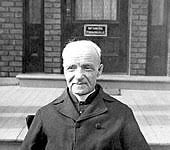Of all the neglected places in church, after the confessional, I’m sure it is the floor. Perhaps that’s for good reason. After Mass, and the fourteen feet with which our children grind mud, raisons, mittens, and run-away cheerios under their soles, what lies beneath the pew is not always pretty. To boot, the carpet doesn’t always start out in good shape. I make a mental list of recent ecclesiastical surfaces over which my feet have shuffled: there’s the toothpaste-green rug of St. Patrick’s; I see now the industrial-grade pile at St. Joseph the Worker; I hear the click of a lady’s heel skipping across the kitchen-floor tile of Our Lady of Perpetual Poverty. Still, it is a pity. A church floor ought to offer more than a place of refuge for squirming toddlers.
Recall that Moses took of his sandals. While the pilgrims at Jerusalem swung their festive palms, they covered the earth with their coats. Indeed, wherever the Lord rests, there we stand on holy ground.
At Thomas More College, where I teach, besides reading the Great Books, everyone learns to decline Latin nouns, to sing, and, in the Way of Beauty sequence, to reproduce ancient and medieval Christian icons and church designs. Among other things, in their drawing classes, students imitate famous “Cosmati” church floor designs, so named after the Roman family which produced generations of decorative mosaics. Inspired by what she learned, one of my students, Amy Green, recently produced her own design and has been working to get it installed at her church. Her home parish is Good Shepherd Catholic Church in Driggs, Idaho. Apparently, the fundraising for the installation is set shortly to begin. Below is pictured the church’s present floor, her design, as well as an original Cosmati pattern.



I recently had a conversation with Amy Green about her proposed floor design. I reproduce below my questions about the project and her answers.
How did you come up with your design?
The design was inspired by the Way of Beauty program taught by David Clayton, artist in residence at Thomas More College of Liberal Arts in New Hampshire. In that program, we learned not only the history but also the symbolism behind the geometric elements of a comatesque floor. The design I am in the process of creating is based off of the original medieval designs that you find in Rome—in particular, the floor of Santa Maria in Trastevere.
How did you argue your case before the Parish? How was it received?
I originally wrote a letter to my parish, offering to design a cosmatesque floor to be constructed in the church. In that letter, I spoke about what St. John Paul II calls the church to: to cultivate within the parish that which is true, good, and beautiful. In that letter I also spoke about the power of beauty to draw all men, Christians and non-Christians alike, to God—how it serves to elevate one’s mind to Christ.
The community immediately responded to this proposal with great enthusiasm; they wanted to begin construction that day! The financial committee, however, was hesitant. They asked that the project wait until the parish was out of debt; I am happy to say, that, as of today, the parish is hoping to be out of debt by the beginning of summer 2015.
The floor is to be walked on. Why should we want it to be beautiful?
The fact that the floor is to be walked on is precisely why it should be beautiful. While this may seem paradoxical, it is a great testament to God’s creation. God created all things to be a reflection of Him, His love and His beauty. Hence, the cosmati floors, complete in their intricate geometrical figures, are meant to reflect the wisdom of the Lord; such patterns draw the mind of the viewer from the depths of the creation up to the wisdom of its creator.
From where did the inspiration for your plan come?
As I say, I was initially inspired by the work of David Clayton as well as the cosmati floors he had our class design for the Way of Beauty program. More specifically, in my sophomore year, when my class went to Rome for a term, my interest was furthered by the cosmati floors I saw in nearly every church. If these churches could be this beautiful, why couldn’t my home parish in Idaho?
When will the church implement it?
The church will begin constructing the floor after all the parish’s debt is paid off as well as all the funds for the tile are raised. This, we pray, will be at the end of summer 2015. I am currently setting up a website where people will be able to learn about the cosmati floor tradition as well as donate to the project.
The construction of the project is unique; the building of the floor itself will be done by the parishioners as well as locals who are not Catholic. It reminds me of the medieval guild systems where the local townspeople would bring their trade and talents to the local parish to help beautify it for the greater glory of God. This project is resurrecting not only the medieval cosmatesque architectural style, but also the medieval way in which the projects were implemented. It is a very exciting opportunity for our parish!









